Hanjo Shrine Festival & Hanshozuka
Yoshie Doi
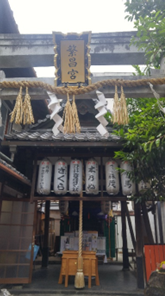 |
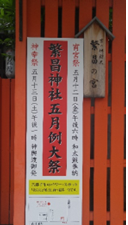 |
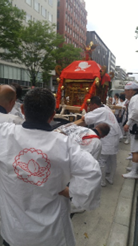 |
Taken on May 13, 2023 at Hanjo Shrine
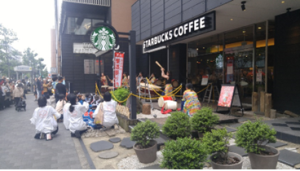 |
Taken on May 13, 2023 Karasuma Kyoto Hotel 1st floor Starbucks
Hanjo shrine festival
On May 13th, 2023, there was a festival at Hanjo Shrine. It was then that I learned for the first time that the Kansai region’s largest taiko lesson hall was located south of Shijo Omiya.
Karasuma Kyoto Hotel is on the first street down Shijo Karasuma Street. The terrace seats of the Starbucks on the first floor became the stage for taiko drum performances in the afternoon, and the beautiful women’s corps played a performance that made the air vibrate comfortably.
There is a banner on Starbucks, and it says “Dedication Hanjo shrine”. The prosperous shrine is located in the west of Takatsuji-dori Muromachi, and is a shrine that has existed since the Heian period. The correct name is “Hanjo shrine”, but as the name “Prosperous” suggests, it is said to bring blessings such as prosperous business, family safety, and good matchmaking. The town name is also a prosperous town.
We do not know exactly when it was built, but in the Heian period, there was a residence of Fujiwara no Shigenari in this area, and Tagorihime no Mikoto was located on an island in the pond in the garden of the residence. Also Tagitsuhime no Mikoto, and Ichikishimahime no Mikoto, the gods of the three sisters, “Munakata San Megami”, are believed to have been enshrined. It’s been handed down. There is Hanjotsuka on the north side of the prosperous shrine.
Hanshozuka
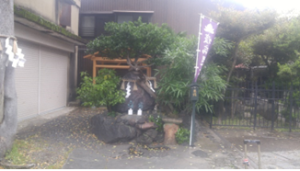 |
If we go down a little alley in Bukkoji Torimurocho, you will find a small shrine and a large rock next to the garage of a private house. It is a 1-minute walk northwest of the prosperous shrine. Legend has it that if an unmarried woman passes in front of this place, the marriage will be broken.
The origin of this mound is described in “Uji Shui Monogatari”. During the Heian period, two daughters of Zenji Nagato lived near Takatsuji, Karasuma. Her sister was married, but her sister was unmarried, and she died of illness, so they carried her coffin to Toribeno. However, when they came to, the coffin was empty. When they brought it back the next day, the body disappeared and was placed at the front door again. Moreover, it is said that they buried the body in this place because they could not move it this time.
Benzaiten, which was enshrined in the mansion (garden) during the Heian-kyo period, is the origin of the name Hanjo. In addition, it seems that the sound changed from the Edo period when this area developed and came to be called Hanjocho.
There is a “Banjozuka” in the alley northwest of Hanjo Shrine. In this area, there are mansions built in Shinden-zukuri style, and it is said that there was a well under the Hanjozuka mound, and a mysterious story remains. After that, her sister moved to another place, and one of the neighbors, who were creepy about her sister’s body being buried, left, then two, and then they were all gone. Over the years, the shinden-zukuri house has decayed, and strangely only the mound remains. Before long, a shrine was built on top of the mound, and it came to be called “Hanjozuka.
This story is the 15th episode of the 3rd volume of “Uji Shui Monogatari”, a collection of story compiled around 1200 in the early Kamakura period, with the title “When the daughter of Zenji Nagato is buried, she returns to Honjo.” It’s a story that’s been told.
Hanjo Shrine is also said to have become “Hanjio Jinja”, a corrupted version of “Hanjou Jinja”, which is said to have been located on the top of Hanjozuka. It’s an auspicious name, but the feeling of resentment for my younger sister who was buried under the mound may still remain. There are rumors that if an unmarried woman passes in front of the Hanjozuka, the marriage will be broken, so it seems that women who are about to get married should avoid the Hanjozuka.。
The end of document
